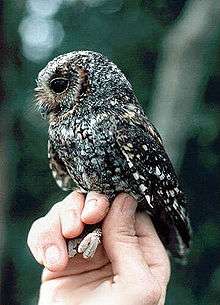Flammulated owl
| Flammulated owl | |
|---|---|
 | |
| Scientific classification | |
| Kingdom: | Animalia |
| Phylum: | Chordata |
| Class: | Aves |
| Order: | Strigiformes |
| Family: | Strigidae |
| Genus: | Psiloscops Coues, 1899 |
| Species: | P. flammeolus |
| Binomial name | |
| Psiloscops flammeolus Kaup, 1853 | |
| Synonyms | |
|
Otus flammeolus | |
The flammulated owl (Psiloscops flammeolus) is a small, nocturnal owl approximately 15 centimetres (6 in) long with a 36 centimetres (14 in) wingspan. Males and females can be distinguished by their weight. Females are larger, ranging from 62–65 grams (2.2–2.3 oz) and males are smaller ranging from 50–52 grams (1.8–1.8 oz). The owl gets the name flammulated from the flame like markings on its face (Bremiller, 2003). It breeds from southern British Columbia and the western United States to central Mexico. It is a neotropical migrant and winters south of the United States but also in Southern Texas, Arizona, and California (Verna,). Unlike many owls, they are migratory, leaving Canada and the United States in the fall. In the winter, they are found in northern Central America, from southern Mexico to Guatemala and El Salvador. Flammulated owls leave their breeding grounds in August to head to their wintering areas and then return to their breeding grounds in late April and early May (Samson, 2005). The flammulated owl is similar in appearance to the western screech owl but is only about one-quarter the mass, lacks large ear tufts (but has small ear tufts that are barely visible), has dark eyes and a different voice. The elf owl is smaller and the mountain pygmy owl is approximately the same size. The call is a series of relatively deep single or double hoots.
Nesting

The flammulated owl nests in tree cavities and has 2–4 young at a time after a 26-day incubation period. The young are able to forage for their own prey after about 25–32 days (Samson, 2005). These owls are obligate cavity nesters meaning they will only create nests in tree cavities and no where else, (Linkhart & Renyolds, 2007). Females usually select cavities that used to be woodpecker or northern flicker nests(Samson, 2005). Their nests are bare and have no nesting material. Flammulated owls tend to form breeding pairs with unoccupied habitat between breeding clusters (Marti). They tend to have one clutch of eggs annually. Like other raptors they can live long and have high nesting success, (Linkhart & Renyolds, 2007). During the nesting period the female owls rely on the males to forage for them, (Linkhart & Renyolds, 2007). Nesting habitat in the western U.S. and Canada is usually mature, open ponderosa pine and Douglas-fir forests. Flammulated owls can also be found breeding in deciduous forests with some conifers present (Marti). In deciduous type habitat flammulated owls can still be productive in terms of breeding.
Diet
They feed almost entirely on insects, but will very occasionally eat small mammals such as shrews and other small rodents. The insects they eat mostly consist of small lepidopteron (Linkhart 2007), which are the moths and butterfly order. They also like to eat crickets and beetles.
Conservation Status
Currently the IUCN (International Union for the Conservation of Nature), lists the flammulated owl as a species of least concern but populations may be declining in some areas.

References
- BirdLife International (2004). Megascops flammeolus. 2006. IUCN Red List of Threatened Species. IUCN 2006. www.iucnredlist.org. Retrieved on 11 May 2006.
- "National Geographic" Field Guide to the Birds of North America ISBN 0-7922-6877-6
- Handbook of the Birds of the World Vol 5, Josep del Hoyo editor, ISBN 84-87334-25-3
- "National Audubon Society" The Sibley Guide to Birds, by David Allen Sibley, ISBN 0-679-45122-6
- Biemiller, L.(2003). Night Vigil. Chronicle of Higher Education, 49 (44),A40.
- Linkhart, B. & Reynolds, R (2007). Return rate, fidelity, and dispersal in a breeding population of flammulated owls (Otus flammerlous) The Auk 124 (1):246-275.
- Marti, C. Flammulated Wols (Otus flammerlous) breeding in deciduous forests.
- Cornell Lab of Orniothology. All About Birds. http://www.allaboutbirds.org/guide/Flammulated_Owl/lifehistory
- Samson, F. B. (2005). A Conservation assessment of the northern goshawk, blacked-backed woodpecker, flammulated owl, and pileated woodpecker in the Northern Region, USDA Forest Service. Unpublished report on file, Northern Region, Missoula, Montana, USA.
External links
- USGS Identification Tips
- photo gallery; RangeMap & synopsis InfoNatura NatureServe
- Flammulated Owl photo gallery - VIREO
- Photo-High Res; Article & short synopsis - Photo gallery
- A recording of the flammulated owl's hoots at the Cornell Lab of Ornithology
